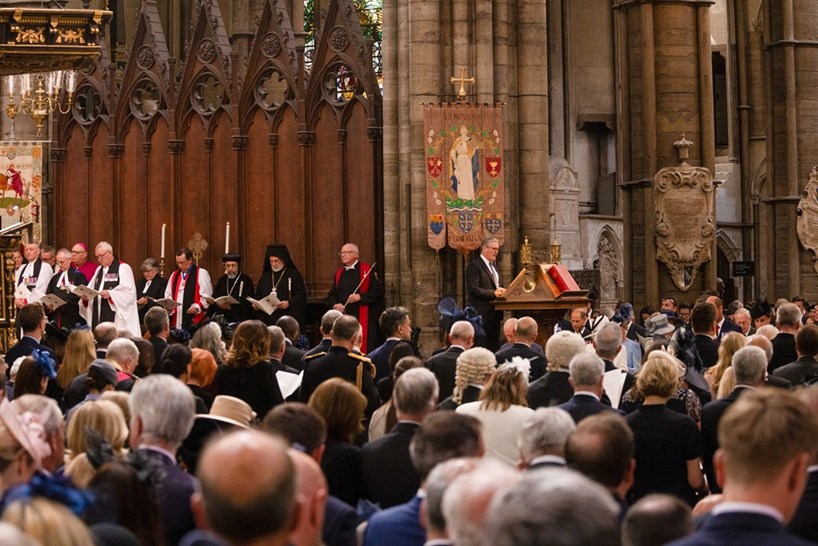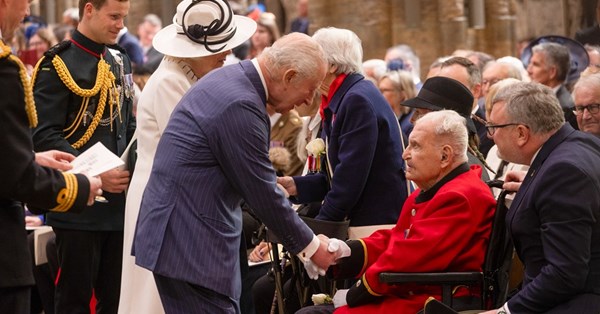JUST before midday on Thursday, the sound of trumpets echoed through Westminster Abbey, heralding the arrival of the King and Queen for the national service of thanksgiving to mark the 80th anniversary of VE — Victory in Europe — Day.
This starkly contrasted with what followed: at noon, a two-minute silence was observed, and the King and Queen joined Prince William and Princess Kate around the Grave of the Unknown Warrior.
As the Choir of Westminster Abbey sang For the Fallen by Douglas Guest, the King laid a wreath of poppies on behalf of the nation and the Commonwealth. Ken Hay, aged 99, who served in the 4th Battalion of the Dorsetshire Regiment, which fought in Normandy, gave Prince William a wreath of colourful flowers to lay on the grave.
The service was attended by more than 1800 people, with 78 veterans in total, displaying their medals on their formal attire.
One veteran was aided by his PTSD service dog, which wore a bandana with the Union flag on it.
Religious leaders, military representatives, members of diplomatic corps and service chiefs filled the Abbey. The Prime Minister, Sir Keir Starmer, read a lesson from St Matthew’s Gospel. Seated with him were other MPs, including Deputy Prime Minister, Angela Rayner, and the Leader of the Opposition, Kemi Badenoch. Former British Prime Ministers, Sir John Major, Lord Cameron, Boris Johnson, and Liz Truss, sat in the nave.
The service was led by the Dean of Westminster, the Very Revd Dr David Hoyle, who read the collect heard in Westminster Abbey on VE Day in 1945: “Remember, O Lord, all those, the brave and the true, who have died the death of honour, and are departed in the hope of resurrection to Eternal Life.”
In his bidding, he said: “We are here to honour those whose courage, strength, and skill through long years of conflict brought victory and a new dawn. We are here to renew our hope and to reaffirm a commitment to a peace that will endure.”
Preaching, the Archbishop of York reflected on the wartime memories of his grandparents and parents (News 8 May). He expressed “hearty and mighty thanks” to those whose sacrifices had made victory possible, and prayed for peace again in Europe.
The Archbishop spoke of the Church, saying, “Like most human institutions, [it] hasn’t always lived up to the high standards of its own calling,” but “the Christian faith has underpinned British law, culture, and identity, and it has helped shape the ideals we celebrate today.”
 Westminster AbbeyThe Prime Minister, Sir Keir Starmer, read a lesson from St Matthew’s Gospel
Westminster AbbeyThe Prime Minister, Sir Keir Starmer, read a lesson from St Matthew’s Gospel
After a rendition of “The White Cliffs of Dover” by Zizi Strallen and the RAF band, Dr Hoyle received artefacts from the Second World War, including a D-Day invasion map, a RAF flying helmet, and a child’s gas mask.
These items represented both the Armed Forces and the Home Front, and they carried in procession through the Abbey by young people from the cadets and Westminster Abbey Choir School, before Dr Hoyle placed them on the high altar.
The actors Josh Dylan and Nina Sosanya read personal wartime letters that had been provided through the Imperial War Museum’s Letters to Loved Ones campaign.
Mr Dylan read a letter written by Lance Corporal Fredrick Burgess to his seven-year-old son seven months before dying on the front line. Ms Sosanya followed with a letter written by Janet Thornton to her young daughters on VE Day in 1945.
An extract of Sir Winston Churchill’s VE Day speech was heard, and his great-great-grandson, Alexander Churchill, aged ten, read a prayer for peace in Europe and around the world.
He also lit the VE Day 80th Candle of Peace, while six members from the 1st Guildford Guides, the Scouts, the Girls’ Brigade, JLGB, and the younth wing of the St John Ambulance distributed white flowers to veterans in the nave.
Music included the hymns “I vow to thee, my country” and “O God, our help in ages past”, and the anthem “My soul, there is a country” from Hubert Parry’s Songs of Farewell, which was sung at the late Queen’s state funeral (News 19 September 2022).
The Duke and Duchess of Edinburgh, the Princess Royal and Sir Tim Laurence, the Duke and Duchess of Gloucester, and the Duke of Kent attended the service.
Unlike previous celebrations, when cheering crowds gathered outside, the immediate surroundings of Westminster Abbey were deserted: just police officers and ceremonial guards stood by the barriers.
At the end of the service, the bells of the Abbey were fired 80 times: that is to say, all sounded simultaneously, a powerful effect reserved for great celebrations.
Before departing, the King and Queen, accompanied by other members of the Royal Family, met veterans in the nave, and the Princess of Wales laid flowers at the Innocent Victims’ Memorial by the great west door.
At 6.30 p.m., church and cathedrals were rung, in an echo of the celebratory bell-ringing of 1945 and as a collective act of thanksgiving.
In 1945, an estimated 25,000 people attended short services of thanksgiving for victory held every hour from 9 a.m. to 10 p.m. at Westminster Abbey. The day has been marked annually since then.
In the evening, the King and Queen attended a celebratory concert in Horse Guards Parade.

















